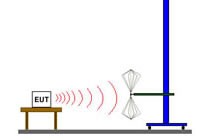How to Perform a Radiated Emissions Measurement
Featured Product from A.H. Systems Inc.

Radiated Emissions Measurement How To
One of the most common EMC test types is the radiated emissions test. Radiated emissions testing is the measurement of the electromagnetic field of the emissions that are unintentionally being generated by the equipment under test. To cover the entire frequency range of interest, several different antennas may be required. Radiated emissions field strength values are measured as follows.
1)Place the antenna at the proper distance from the source of the emissions, or the equipment under test. Typically this distance would be a 3, 10 or 30 meter separation depending on the test standard
2)Position the antenna at the product being tested. This includes bore-site direction, and polarization (polarity).
3)Connect the output of the receiving antenna to the input of the receiving system (spectrum analyzer used to measure field), using a low VSWR, low loss coaxial cable. The input impedance for the receiving system, and the receiving antenna should all be matched to 50W. Most antennas are already matched to this impedance, if they are EMI/EMC antennas, as should most receiving systems. If this is not the case, the readings will require correction for the impedance mismatch.
4)Select the frequency of interest on the receiving system. Ensure that the receiving antenna is capable of providing accurate measurements at that frequency. This includes ensuring the antenna can receive a signal at the frequency of interest by its designed frequency range, provided by the manufacturer, and that the antenna is properly calibrated at that frequency.
5)Measure the RF Voltage, Va, referenced to the receiving system. The units should be in decibels referenced to 1 micro-volt, dBmV. If the units are in absolute micro-volts (dependent on the receiving system used) they should be converted. The conversion factors are as follows, however, more information about the conversion (and other useful formulas for RF related conversions) can be found in the RF conversion technical note.
Antenna Calibration Services
Annual recalibration is important to ensure repeatable and reliable data. At our facility, we calibrate our own antennas, as well as, most other brand antennas in accordance with SAE, ANSI, IEEE and CISPR specifications.
Antenna Beamwidth Measurement Services
We are pleased to offer antenna beamwidth measurement services. Our computer controlled automated antenna pattern measurements covers a wide frequency spectrum up to 40 GHz.
Antenna Rental Services
Our primary focus is providing a complete rental solution of test antennas and accessories to industries such as Aerospace, Defense, Communications, EMC, and more. We maintain a wide inventory of many of our products that we manufacture and can deliever next-day for an on-tim solution.
Welcome to A.H. Systems, inc.
A.H. Systems has been established since 1974 and manufactures a complete line of affordable, reliable, EMI test equipment. Our individually calibrated EMI Test Antennas, Preamplifiers, Current Probes and Low-Loss Cables satisfy many test standards including CISPR, MIL-STD, FCC, EN, VDE, IEC and SAE. With a wide variety of mounting configurations, we can also offer tripods and accessories that compliment other EMI testing equipment used to complete your testing requirements. We are also committed to providing all of our clients with no cost prompt and professional technical support. Manufacturing high quality products at competitive prices with immediate shipment plus prompt technical support are our goals to improve the quality of your testing requirements.